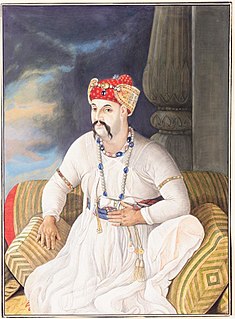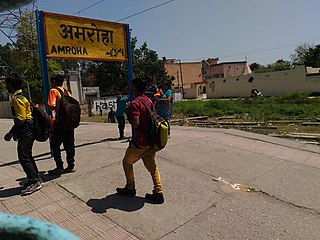Related Research Articles

Awadh, known in British historical texts as Avadh or Oudh, is a region and proposed state in the modern Indian state of Uttar Pradesh, which was before independence known as the United Provinces of Agra and Oudh. Awadh is bounded by the Ganges Doab to the southwest, Rohilkhand to the northwest, Nepal to the north, and Bhojpur-Purvanchal to the east. Its inhabitants are referred to as Awadhis.

The siege of Lucknow was the prolonged defence of the British Residency within the city of Lucknow from rebel sepoys during the Indian Rebellion of 1857. After two successive relief attempts had reached the city, the defenders and civilians were evacuated from the Residency, which was then abandoned.

Allahabad High Court, also known as High Court of Judicature at Allahabad is the high court based in Prayagraj that has jurisdiction over the Indian state of Uttar Pradesh. It was established on 17 March 1866, making it one of the oldest high courts to be established in India.

Barabanki district is one of the five districts of Faizabad division, in the central Awadh region of Uttar Pradesh, India. Barabanki city is the administrative headquarters of Barabanki district. Total area of Barabanki district is 3891.5 Sq. Km.

Asaf-ud-Daula was the Nawab wazir of Oudh ratified by Shah Alam II, from 26 January 1775 to 21 September 1797, and the son of Shuja-ud-Dowlah. His mother and grandmother were the Begums of Oudh.

The Capture of Lucknow was a battle of Indian rebellion of 1857. The British recaptured the city of Lucknow which they had abandoned in the previous winter after the relief of a besieged garrison in the Residency, and destroyed the organised resistance by the rebels in the Kingdom of Awadh.
Alli is a surname and a unisex given name. Notable people with the name include:

The Chattar Manzil, or Umbrella Palace is a building in Lucknow in Uttar Pradesh which served as a palace for the rulers of Awadh and their wives.

The Nawab of Awadh or the Nawab of Oudh was the title of the rulers who governed the state of Awadh in north India during the 18th and 19th centuries. The Nawabs of Awadh belonged to a dynasty of Persian origin from Nishapur, Iran. In 1724, Nawab Sa'adat Khan established the Oudh State with their capital in Faizabad and Lucknow.

Dilkusha Kothi is the remains of an eighteenth-century house built in the English baroque style in the quiet Dilkusha area of Lucknow in India. Today there are only a few towers and external walls as a monument, though the extensive gardens remain. The house was shelled during its involvement in the Lucknow siege in 1857 together with the Residency and the nearby school of La Martiniere.

Ghazi-ud-Din Haidar Shah was the last nawab wazir of Oudh from 11 July 1814 to 19 October 1818, and first King of Oudh from 19 October 1818 to 19 October 1827.
Events in the year 1858 in India. Act of Parliament 1858

Lucknow Charbagh is one of the five main railway stations of Lucknow city for 5 ft 6 in broad gauge trains, the other ones being Lucknow Junction, Gomti Nagar railway station, Aishbagh Railway Station and Lucknow City. In 19th century, the next important station in the north after Delhi was Lucknow. It was the headquarters of the Oudh and Rohilkhand Railway (O&RR) owned by satwik arya

Bareilly Junction railway station is a railway station serving Bareilly city in Uttar Pradesh. It is an important station as well as the headquarters of Izzatnagar railway division of the North Eastern Railway zone & Moradabad railway division of the Northern Railway zone. It lies on Lucknow–Moradabad line and Lucknow-Sitapur-Lakhimpur-Pilibhit-Bareilly-Kasganj Line provides a stop for most trains passing through. Bareilly Junction used to serve both broad and metre gauge, Bareilly Junction was connected to Lucknow by both Broad Gauge and Meter Gauge, Broad Gauge was connected to Lucknow via Shahjahanpur, Hardoi. On the other hand Meter Gauge was connected to Lucknow via Pilibhit-Mailani-Lakhimpur-Sitapur, but now the metre gauge is converted into broad gauge.
Oudh and Rohilkhand Railway was an extensive railway network in the North India, mostly north of the Ganges, starting from Benares and subsequently up to Delhi.
Unnao Junction railway station is on the Lucknow–Kanpur Suburban Railway and Varanasi–Kanpur branch line. It is located in Unnao district in the Indian state of Uttar Pradesh. It serves Unnao and the surrounding areas.
Rohilkund and Kumaon Railway (R&KR) was a metre gauge railway in India covering a total network of 592 miles (953 km). It was owned and worked by the Rohilkund and Kumaon Railway Company. The Rohilkund and Kumaon Railway was transferred to the Government of India and merged into the Oudh and Tirhut Railway on 1 January 1943.

The Oudh State was a princely state in the Awadh region of North India until its annexation by the British in 1856. The name Oudh, now obsolete, was once the anglicized name of the state, also written historically as Oudhe.

Amroha railway station is a main railway station in Amroha district, Uttar Pradesh established in 1885. Its code is AMRO. It serves Amroha city. The station consists of three platforms. The platforms are not well sheltered. It lacks many facilities including water and sanitation.
Rampur Junction railway station is located in Rampur in Uttar Pradesh.
References
- Union List of Artist Names, s.v. "Alli, Darogha Ubbas". Accessed 4 December 2006.